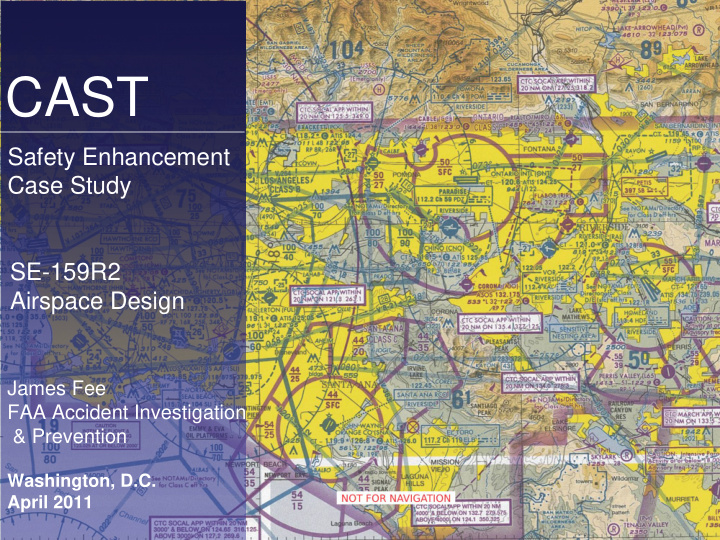



CAST Safety Enhancement Case Study SE-159R2 Airspace Design James Fee FAA Accident Investigation & Prevention Washington, D.C. April 2011 April 2011
History of SE-159R2 • Safety Enhancement (SE) 159 was developed by the Midair sub team of the Remaining Risk JSAT/JSIT • Resulted from the Aero México Flt. 498 accident in Cerritos, CA – Collision between DC-9 and PA-28 – Fatalities: 67 onboard both aircraft and 15 on ground April 2011
CAST Proposal to Aero Charting Forum • Eliminate hypsometric tint following the outer boundaries of Class B airspace areas to enhance identifiably on VFR charts. An example of this enhancement is found on the Washington VFR chart series applied against the Washington DC Metropolitan Area Special Flight Rules Area symbol. • Eliminate hypsometric tint inside VFR Transition Route symbols. An example of this enhancement is found on VFR charts which eliminated hypsometric tint inside class airspace frequency boxes on visual charts. April 2011
What would it look like? April 2011
What would it look like? April 2011
ATO Safety Risk Management (SRM) Analysis • ATO conducted a Safety Risk Management (SRM) Analysis on the proposed enhancements and issued the following findings: #1 Increased cost of printing the color white on charts resulting in redirected resources away from agency NAS priorities. Ranking B5, probable chance, no safety impact to NAS #2 Human Factors impact of change due to the use of an unfamiliar color on the chart. Ranking C5, remote chance, no safety impact to NAS. #3 Loss of visibility of items that fall under the new white color. Ranking B4, probable chance, minor safety impact to NAS. #4 Resource impact of adjusting all charts may take away resources used to complete stated agency priorities on flight procedures production. Ranking B4, probable chance, minor safety impact to NAS. Mitigation strategy: Make changes as charts are normally updated and not as a single effort. April 2011
April 2011
ASIAS Directed Study on TCAS RAs: Location from FOQA Data Over a three-year period, Southern California, Northern California, and Denver accumulated the greatest concentrations of TCAS RA events. * 11 April 2011
Class B Airspace Study • As a result of the August 2009 New York Hudson River midair collision NTSB recommended a review of all class B airspaces to identify where safety could be improved. – FAA Aviation Safety Information Analysis and Sharing (ASIAS) conducted a review of event reports • for areas where pilot training and special flight rules would improve safety, as suggested by the NTSB, • and to understand the impact of the air traffic, and its associated procedures, en route to, within, and departing from class B airspace. April 2011
Where next? • The data pull resulted in approximately 45,000 reports – Near Midair Collision System (NMACS) – NASA Aviation Safety Reporting System (ASRS) – Pilot Deviation System (PDS) – Operational Error/Deviation System (OEDS) – NTSB Accident and Incident Database – FAA Accident/Incident Data System (AIDS) • After the analyst review was complete, 629 reports remained for SME review, of which 141 were indicated that a traffic conflict occurred in or near Class B airspace. April 2011
Class B Airspace Traffic Conflict Contributing Factors and Locations April 2011
Class B Airspace Conflict Flight Conditions and Event Description April 2011
Recommend
More recommend